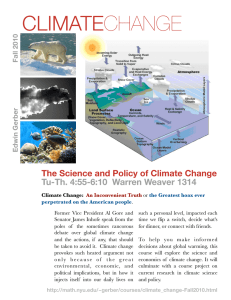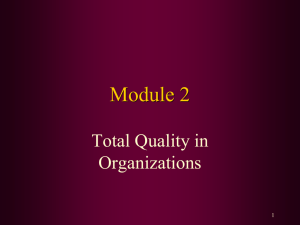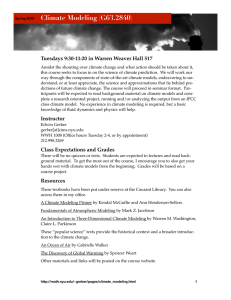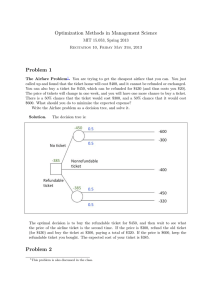Document 13619611
advertisement
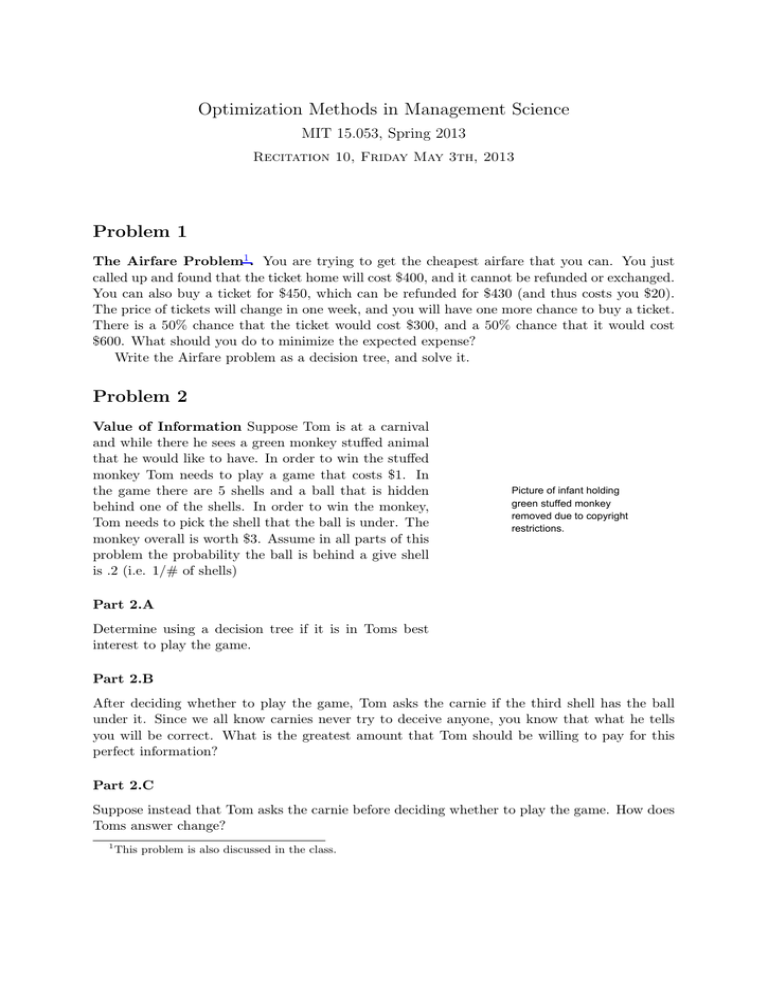
Optimization Methods in Management Science MIT 15.053, Spring 2013 Recitation 10, Friday May 3th, 2013 Problem 1 The Airfare Problem1 . You are trying to get the cheapest airfare that you can. You just called up and found that the ticket home will cost $400, and it cannot be refunded or exchanged. You can also buy a ticket for $450, which can be refunded for $430 (and thus costs you $20). The price of tickets will change in one week, and you will have one more chance to buy a ticket. There is a 50% chance that the ticket would cost $300, and a 50% chance that it would cost $600. What should you do to minimize the expected expense? Write the Airfare problem as a decision tree, and solve it. Problem 2 Value of Information Suppose Tom is at a carnival and while there he sees a green monkey stuffed animal that he would like to have. In order to win the stuffed monkey Tom needs to play a game that costs $1. In the game there are 5 shells and a ball that is hidden behind one of the shells. In order to win the monkey, Tom needs to pick the shell that the ball is under. The monkey overall is worth $3. Assume in all parts of this problem the probability the ball is behind a give shell is .2 (i.e. 1/# of shells) Picture of infant holding green stuffed monkey removed due to copyright restrictions. Part 2.A Determine using a decision tree if it is in Toms best interest to play the game. Part 2.B After deciding whether to play the game, Tom asks the carnie if the third shell has the ball under it. Since we all know carnies never try to deceive anyone, you know that what he tells you will be correct. What is the greatest amount that Tom should be willing to pay for this perfect information? Part 2.C Suppose instead that Tom asks the carnie before deciding whether to play the game. How does Toms answer change? 1 This problem is also discussed in the class. Problem 3 Gerber Product, Inc. (True story from 1998-99. <http://gbr.pepperdine.edu/993/tree.html>) Gerber Products, Inc. needs help in deciding whether to continue using the plastic known as PVC in pacifiers and feeding products. PVC, a composite plastic, is made pli­ Gerber logo able with a softening chemical called phthalates. Although removed due to copyright phthalates have been used in plastic for over 30 years with­ restrictions. out any cases of health problems, Greenpeace announced that their scientific testing on the chemical has been found it to be carcinogenic in lab rats. Due to this announcement the Consumer Product Safety Commission has decided to study the matter further and issue a press release with their results. This is the point at which Gerber decides to im­ plement a decision tree. Gerber faces two choices: be reactive, wait for the an­ nouncement, and gauge consumer response before deciding on a course of action; or be proactive and pursue resolution regardless of the publics response to the report. The CSPC will either issue an unfavorable report recalling of all products with phthalates, or a more favorable one expressing minimal concern over the issue. The two reports have equal probability. If Gerber chooses to be proactive, they can choose to discontinue all products with PVC. In this case if the report is favorable, there is an 80% chance that the public would react favorably causing sales to increase by $1 million, but also there is a 20% chance that sales would decline by $1 million. If the report is negative there is a 25% likelihood that Gerber could preserve current sales, but also a 75 % probability that a recall would hurt sales by $1.25 million. In the event that Gerber waits for the CSPC report before taking action. With a favorable report and a delayed response, there is a 25% chance that sales would remain flat, along with a 75% chance that sales would decline by $2 million. The worst-case scenario is if Gerber remains passive and there is a recall. In that case, there is still a 20 % probability that Gerber could increase sales by $.5 million. However, it was considered an 80% probability that significant volume would be lost ($10 million). Part 3.A Set up the decision tree and find the optimal decision for Gerber. Part 3.B In the worst case scenario, Gerber would be compensated for some of their losses. How much would Gerber need to be compensated so that Gerber would act passively? 2 MIT OpenCourseWare http://ocw.mit.edu 15.053 Optimization Methods in Management Science Spring 2013 For information about citing these materials or our Terms of Use, visit: http://ocw.mit.edu/terms.
